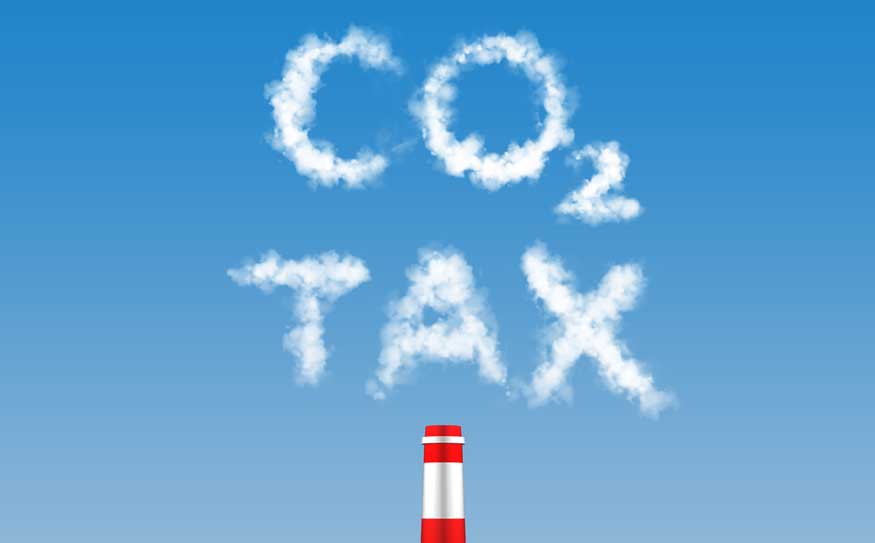
In the Copenhagen Accord (UNFCCC, 2010), during COP15, 114 countries agreed that “the increase in global temperature should be below 2°C, on the basis of equity”. This has been interpreted as the “dangerous” level agreed to by the parties in the UN Framework Convention on Climate Change (1992). To have a more likely than not chance at staying below 2°C, the concentration of carbon dioxide in the atmosphere cannot exceed 500ppm (IPCC, 2014). Every 2.13 GtCO2 emitted will raise the concentration of carbon dioxide in the atmosphere by 1ppm (Carbon Dioxide Information Analysis Center, 2012). As of September 2014, the carbon dioxide concentration in the atmosphere was 395 ppm (NOAA, 2014). Thus, there is approximately 224 more GtCO2 that can be emitted until there is a less likely than not chance of having warming greater than 2°C. To reach this level of atmospheric carbon dioxide, global emissions must be reduced by 40-70% by 2050 and be at zero or negative emissions by the end of the century (IPCC, 2014). A carbon tax is the most effective way to make the transformative change needed to keep emissions below the agreed upon dangerous level of atmospheric GHGs. An aggressive carbon tax will allow dangerous climate change to be avoided because it is proven to work, it can be implemented quickly, and it has the potentially to drastically reduce emissions.
A carbon tax is an effective tool to mitigate emissions in a least cost manner. Every use of fossil fuels that is worth less than the price of the emissions will not occur and thus reduce emissions. As the fee rises, more carbon intensive activities will become economically infeasible, driving down GHG emissions. Depending on the original fee and rate of increase this would be an effective tool to rapidly decrease emissions at the least cost because market forces will drive carbon reductions. By setting a tax floor, emission reductions are ensured (as opposed to a price cap in cap-and-trade systems) and increase over time with price increases (Sawin and Moomaw, 2009). A cap-and-trade system will be associated with less certain emissions reductions because an emissions cap is also an emissions floor (Burtraw and Woerman, 2012). This means that maximum emissions reductions cannot always be achieved because the number of permits issued sets the reduction amount as opposed to market forces pushing emissions with economic forces. This tax scheme allows for efficient carbon reductions.
Several European countries have already put a tax on carbon. Denmark was able to do this successfully by taxing industry emissions to fund renewable energy projects (Sawin and Moomaw, 2009). Denmark proved that the carbon tax works when you tax the polluters and subsidize renewable energy (Prasad, 2008). A recent study even found that a majority of republicans, democrats and independents in the United States would support a carbon tax similar to Denmark’s in which all revenues would be returned to research and development of renewable energies (Amdur, 2014). This could make a carbon tax feasible in the US and allow for economically efficient emissions reductions.
During the last week of October 2014, Senator Sheldon Whitehouse announced his intentions to introduce a carbon fee bill to the US Senate (Pantsios, 2014). This bill would put a price on the carbon to fund social programs including helping workers transition out of carbon intensive jobs (Pantsios, 2014). Two MIT economists hypothesize that it is better for the economy to have carbon taxes than high federal taxes (specifically looking at the expiration of the Bush-era tax cuts) even if those funds go towards social programs or tax cuts (Rausch and Reilly, 2012). For all these reasons, it seems like a carbon fee bill would do well in US congress; it makes logical sense, but the politics can get messy.
Australia passed a carbon tax in 2012 (Meng and others, 2013) under a pro-labor government attempting to reach across party lines to gain votes (Taylor and Hoyle, 2014). The politics around this legislation have been messy for a number of years and in 2014 the law was repealed under the notion that it hurts business and is preventing Australia from exporting its rich energy resources to countries across the world (Taylor and Hoyle, 2014). AGL Energy was cited as saying that this would cause a loss in revenue in the near term due to loss in assistance from the government/carbon tax; however, long-term profits are now looking up (Taylor and Hoyle, 2014). This could lead to backlash from citizens as the government takes away a A$500+ check, which was promised to households in the form of yearly savings (Taylor and Hoyle, 2014). Australia is the first example of a nation to pass a carbon fee and then later repeal it. A program, which gives money to the citizens, would seem to have broad voter appeal, like British Columbia’s program (2014). It appears that the politics were not set up properly for Australia to have a carbon fee that sticks. This does not mean that a carbon fee is impossible, but rather that care must be taken to set up a program that is politically feasible.
Nationally Appropriate Mitigation Actions (NAMAs) are a good first step and should not be discourage amongst UNFCCC parties. To be effective, an agreement with a great deal of stringency, participation and compliance must be reached in Paris. It does not appear to be politically feasible, but if a global price on carbon could be agreed upon, this would allow for the best system to tie everyone together ensuring participation and compliance. The tax could provide increasing stringency over time to ensure effectiveness. This would allow certainty around carbon leakage out of countries with strict carbon rules and into low regulation nations. The carbon tax is a clear transformation change that would work to drive emissions down. Incremental changes and small policy reforms are unlikely to put the world in a position to mitigate warming below 2 degrees Celsius. Effective and decisive action is needed immediately to instill transformative change.
Works Cited
Amdur, D., Rabe, B., Borick, C. Public Views on a Carbon Tax Depend on the Proposed Use of Revenue. Issues in Energy and Environmental Policy. Number 13. July, 2014.
British Columbia. Carbon Tax. Ministry of Finance. 2014.
Burtraw, Dallas, and Matt Woerman. “US status on climate change mitigation.” Resources for the Future (RFF) Discussion Paper (2012): 12-48.
Carbon Dioxide Information Analysis Center. Carbon Dioxide Information Analysis Center – Conversion Tables. September, 2012.
IPCC, 2014: 5th Assessment Synthesis Report, Summer for Policy Makers. [Myles R. Allen (United Kingdom), Vicente Ricardo Barros (Argentina), John Broome (United Kingdom), Wolfgang Cramer (Germany/France), Renate Christ (Austria/WMO), John A. Church (Australia), Leon Clarke (USA), Qin Dahe (China), Purnamita Dasgupta (India), Navroz K. Dubash (India), Ottmar Edenhofer (Germany), Ismail Elgizouli (Sudan), Christopher B. Field (USA), Piers Forster (United Kingdom), Pierre Friedlingstein (United Kingdom), Jan Fuglestvedt (Norway), Luis Gomez-Echeverri (Colombia), Stephane Hallegatte (France/World Bank), Gabriele Hegerl (United Kingdom), Mark Howden (Australia), Kejun Jiang (China), Blanca Jimenez Cisneros (Mexico/UNESCO), Vladimir Kattsov (Russian Federation), Hoesung Lee (Republic of Korea), Katharine J. Mach (USA), Jochem Marotzke (Germany), Michael D. Mastrandrea (USA), Leo Meyer (The Netherlands), Jan Minx (Germany), Yacob Mulugetta (Ethiopia), Karen O’Brien (Norway), Michael Oppenheimer (USA), R.K. Pachauri (India), Joy J. Pereira (Malaysia), Ramón Pichs- Madruga (Cuba), Gian-Kasper Plattner (Switzerland), Hans-Otto Pörtner (Germany), Scott B. Power (Australia), Benjamin Preston (USA), N.H. Ravindranath (India), Andy Reisinger (New Zealand), Keywan Riahi (Austria), Matilde Rusticucci (Argentina), Robert Scholes (South Africa), Kristin Seyboth (USA), Youba Sokona (Mali), Robert Stavins (USA), Thomas F. Stocker (Switzerland), Petra Tschakert (USA), Detlef van Vuuren (The Netherlands), Jean-Pascal van Ypersele (Belgium)]. November 1, 2014.
Meng, S, Siriwardana, M., and McNeill, J. “The environmental and economic impact of the carbon tax in Australia.” Environmental and Resource Economics 54.3 (2013): 313-332.
Monica Prasad, “On Carbon, Tax and Don’t Spend,” New York Times, 25 March 2008.
NOAA. National Oceanic and Atmospheric Administration Earth Systems Research Laboratory Global Monitoring Division. Trends in Atmospheric Carbon Dioxide. October, 2014.
Patsios, Anastasia. Sen. Whitehouse Proposes Carbon Tax to Repay Citizens for Pollution Costs. Eco-watch. October, 2014.
Rausch, S., and Reilly, J. Carbon tax revenue and the budget deficit: A win-win-win solution?. MIT Joint Program on the Science and Policy of Global Change, 2012.
Sawin, J., and Moomaw, W.. Renewable revolution: low carbon energy by 2030. Worldwatch Institute, 2009.
Taylor R. and Hoyle R. Australia Becomes First Developed Nation to Repeal Carbon Tax. The Wall Street Journal. July, 2014.
UNFCCC. Copenhagen Accord. “Report of the Conference of the Parties on its fifteenth session, held in Copenhagen from 7 to 19 December 2009.” UNFCCC/CP/2009/11/Add.1. March 30, 2010.
UNFCCC. United National Framework Convention on Climate Change. UNFCCC/INFORMAL/84. 1992.



